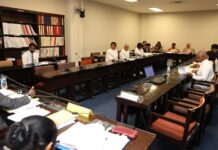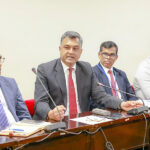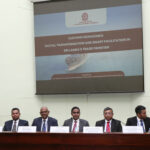Sri Lanka’s Central Bank, which is advocating import controls and is also the banking regulator, did not approve the opening of letters of credit to bring down luxury SUVs for parliamentarians, Governor W. D. Lakshman said.
The LC was opened by a state bank, according to information that is now public.
“The Central bank has not given such an approval (ava-sa-rer dee-muck). “We also got to know about that story later,” Governor Lakshman told reporters at an online media briefing.
There has been public anger at elected ruling class importing SUVs while the ordinary public is barred from importing three wheelers after tax cuts and money printing.
The elected ruling class also get tax free SUVs and state workers get tax slashed cars while ordinary people pay taxes of close to 300 per cent for some vehicles in a modern day feudal-overload-to-serf style taxation system.
“I see it as a difficult question to justify. It should be asked from the Bank of Ceylon and the state institution that gave instructions to the Bank of Ceylon,” Governor Lakshman said.
The central bank regulates all commercial banks and can issue direction on letters of credit and their margins.
However most import controls are issued under the Import and Export Control Act brought in during the administration of then Prime Minister Dudley Senanayake, shortly before the collapse of the Bretton Woods system of soft-pegs.
It came shortly after the UK currency also collapsed against the US dollar (and gold) in a 1967 ‘Sterling crisis’ in the pursuit of similar policies.
Sri Lanka has a had a longtime practice of controlling imports after the central bank injects liquidity, de-stabilzing a soft-peg with the US dollar, instead of restraining the central bank’s domestic operations.
The import control law was used extensively during the 1970s under Sri Lanka’s closed economy after the Bretton Woods system collapsed in the wake of money printing by the Federal Reserve in the pursuit of Keynesian policies under then Fed Chief Arthur Burns, triggering commodity bubbles and high inflation.
The money printing Burns was appointed after the Fed’s longest serving Chairman William McChesney Martin who was raising rates to reduce money printing was replaced by President Richard Nixon in February 1970, ostensibly to block him from triggering a recession.
The President broke the Bretton Woods system on August 1970 by ‘closing the gold window’, a term used to describe the floating of the US dollar and ending entire world’s centuries old gold peg.
He also issued executive order 11615 containing a series of Mercantilist, non-monetary measures to try to regain monetary stability, instead of controlling the central bank, including import duty hikes, generally known as the Nixon shock.
The Fed was finally tamed under President Ronald Reagan and Fed Chairman Paul Volcker, who was Undersecretary for International Monetary Affairs when the Bretton Woods peg was broken.












